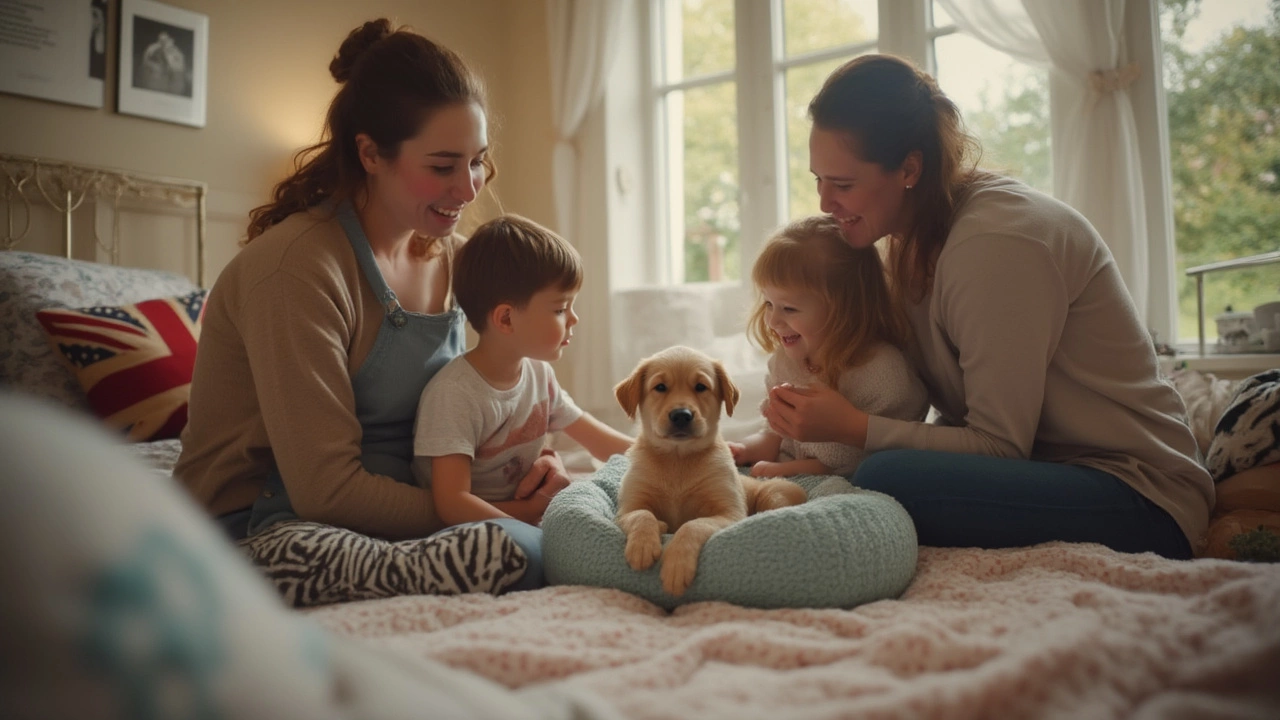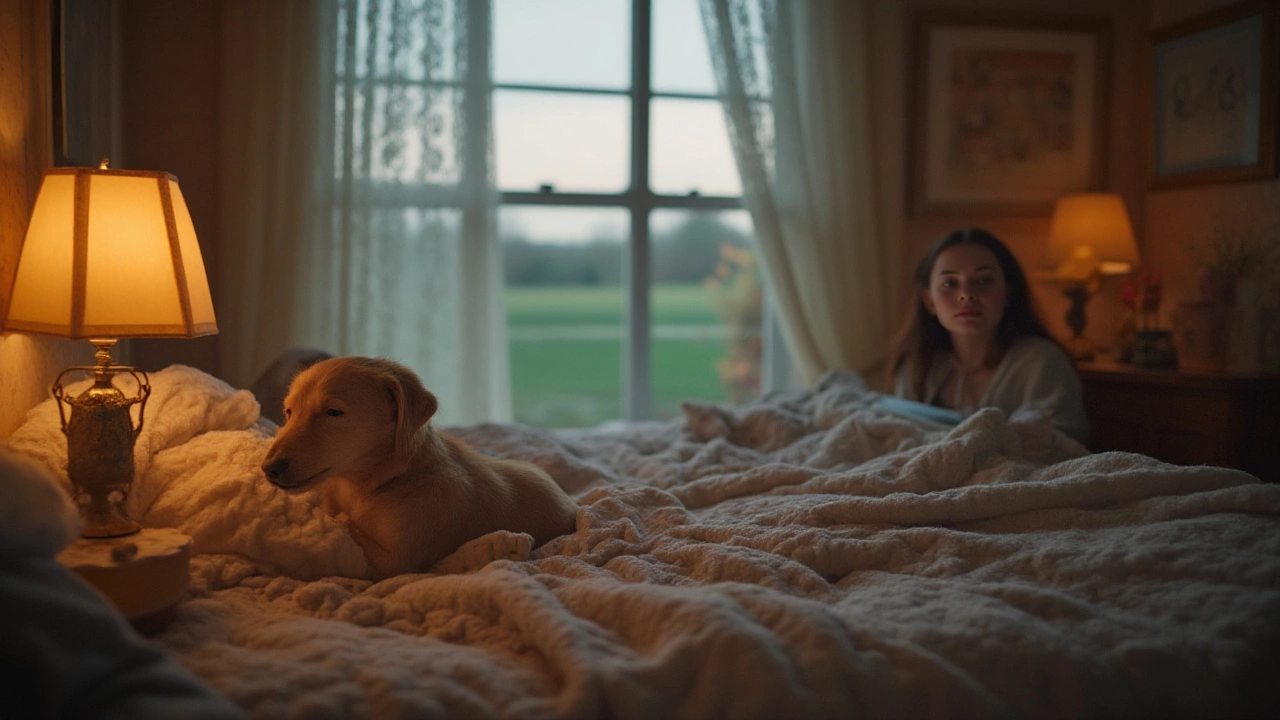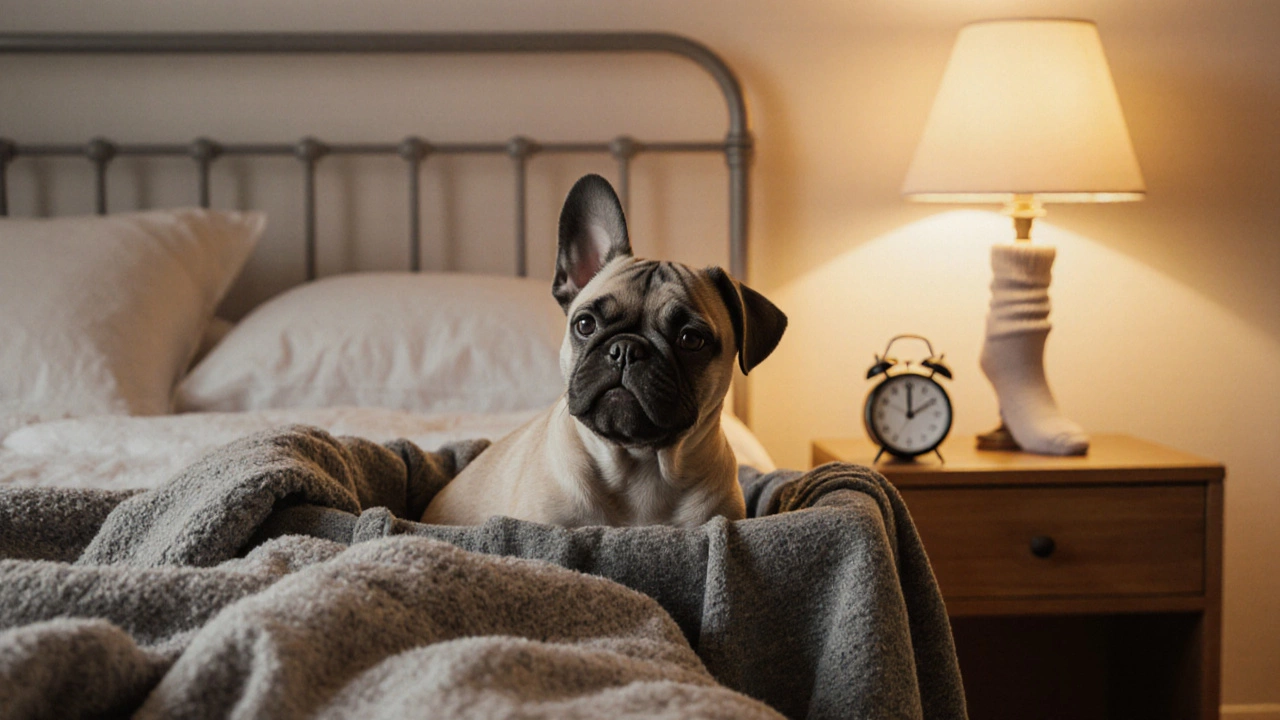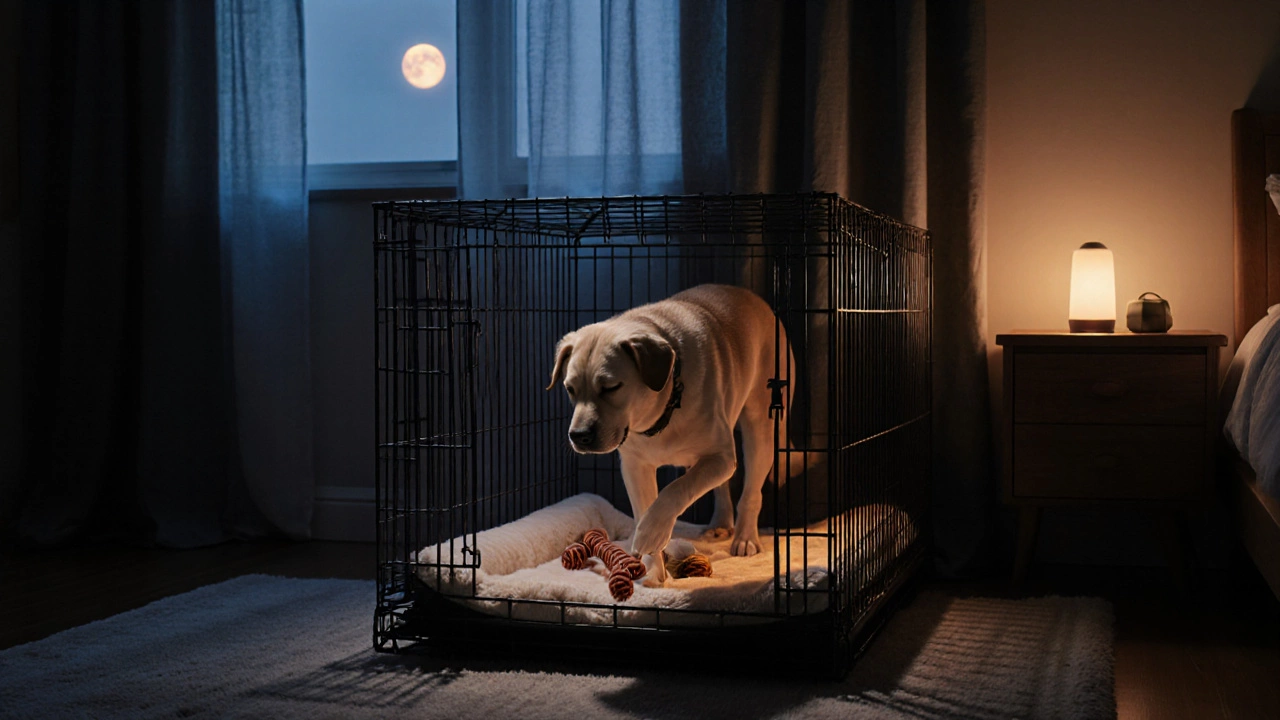You finally brought home a wiggly ball of fur, and reality hits as dusk falls. That innocent face, those wide eyes—how can you say no when your puppy whimpers at night? Some folks swear by crate training in a separate room. Others won’t sleep a wink unless their new buddy is curled up beside them. The real question: should you sleep in the same room as your puppy? There’s no one-size-fits-all, but the choice shapes more than just your night’s rest.
Understanding Puppy Sleep and Bonding: What Science Says
When it comes to puppies, their first weeks are a whirlwind of learning, bonding, and adapting. Puppies under 16 weeks crave security more than anything else. In their earliest days, sleep helps with memory and brain development. Most puppies sleep 18–20 hours a day—not just to rest, but to process all the new smells, sounds, and sensations around them. Dr. Katherine Houpt, a veterinary behaviorist at Cornell, points out that puppies deprived of comfort or safety can develop deep-seated anxiety that sticks with them for life.
It might surprise you, but studies in both animal behavior and childhood development show the importance of sleep proximity for forming strong, confident bonds. One paper from the University of Lincoln highlighted how co-sleeping (not necessarily bed-sharing) in the first weeks supports secure attachment. Dogs, much like human babies, want to know you’re there. That doesn’t mean you should automatically tuck your puppy under the covers—but it does mean where your pup sleeps can shape how safe they feel and how quickly they learn to trust.
Puppies have tiny bladders and little control, especially before 12 weeks. If you’re sleeping separately, expect lots of nighttime bathroom calls and cries for comfort. That’s not a sign of spoiled behavior, it’s just how puppies work. The sound of your breathing and even your scent can lower their heart rate and cortisol (the stress hormone), researchers found. In fact, puppies sleeping near their people wake up less often and fall back asleep quicker after a midnight potty break.
Some data points are worth repeating: The American Veterinary Society of Animal Behavior (AVSAB) has noted that dogs allowed close human contact during initial settling show fewer signs of separation anxiety later. Here’s the risk—if you leave a young puppy alone right away, there’s a higher chance your dog learns to associate the night (and being alone) with fear or tension. That can turn into clingy behavior, barking, or even house-training setbacks. So, the place where your puppy sleeps isn’t just about convenience—it can set the stage for your pup’s emotional health.
Now, what about sleep training? There’s a big difference between sharing a room and sharing a bed. Some folks move the crate next to their own bed so their puppy can hear, smell, and sense their presence. This simple act can cut down whining by up to 40% in the first two weeks, as noted in a 2023 survey of new dog owners. Moving the crate farther away, bit by bit, gives your puppy time to build confidence. As the weeks go on, many find the transition from bedroom to hallway, then to a separate space, goes way smoother if you start together and branch out slowly.
The Benefits of Sleeping in the Same Room as Your Puppy
Still on the fence? Plenty of pet owners admit that sleeping in the same room kickstarted their bond with their pup. Whether you choose to have the crate nearby or let your puppy sleep on a dog bed, the proximity brings lots of perks—for both you and your new furball.
First off, sleeping together simply speeds up trust. It’s almost like speaking a secret language of safety and togetherness. Puppies that feel safe at night are calmer during the day, which helps them learn faster and cope with new experiences. If you think of your bedroom as a puppy’s “den,” you’re building their confidence to face the world. This has ripple effects: fewer behavioral problems and easier adaptation to family rules, according to research from the American Kennel Club’s Canine College.
Let’s talk about separation anxiety. Every year, thousands of dog owners struggle with barking, scratching, or accidents that seem to come out of nowhere. About 14% of dogs globally experience some form of separation-related problem, says a 2022 study in the journal Animals. The root? Often, they were left alone too soon or for too long as puppies. Sharing a room from the start can keep those worries in check. Your scent, sounds, and even the light from your phone can reassure a restless pup, helping them understand they’re not truly alone. And if your puppy needs a midnight toilet break, you’ll catch it faster—no piles to clean in your slippers the next morning.
From a practical side, you’ll spot problems earlier. If your puppy’s not sleeping well, wheezing, scratching, or suddenly restless, you’ll notice it fast. You’ll also be first to notice if your puppy’s chewing his crate, tossing treats around, or inventing new tricks to escape bedtime. This real-time feedback can save your shoes, your carpet, and your sanity.
Some owners worry they’ll “spoil” their dog by sleeping together, but over 70% of trainers surveyed by the International Association of Animal Behavior Consultants say that forming a close bond early builds a more independent dog long-term. Not to mention, you’ll probably sleep better, knowing your puppy isn’t in distress down the hall.
So, what about allergies or light sleepers? Keeping a puppy in a crate beside your bed keeps dander in check and doesn’t interrupt your rest as much as a puppy in bed. Many allergy sufferers handle this by using HEPA air filters and sticking with frequent bedding washes. It’s all a balancing act—room-sharing is not all-or-nothing.

The Downsides: When Sharing Space Isn’t Ideal
Now, there’s no such thing as a free lunch—sleeping in your puppy’s orbit can have pitfalls. Some dogs grow up to weigh as much as a small adult. If you rush into full-blown bed-sharing, you might set a habit that’s tough to break. Letting a St. Bernard puppy in your bed means a 180-pound roommate in six months.
Even if your puppy starts off in a crate, some will test your boundaries. Expect nights where your puppy might whine for fun, want another bathroom trip, or bark just to see what happens. Owner surveys from the UK showed nearly half dealt with disrupted sleep in the first month—think bark alarms at 3 a.m. sharp. If you’re a light sleeper, those puppy dreams (all the yips, kicks, and wiggles) can keep you up for hours.
Allergies do flare up for some. Despite the benefits, about 20% of dog owners report new or worse allergy symptoms after bringing a dog into the bedroom, says a 2024 survey published by the Asthma and Allergy Foundation of America. If you have a partner or spouse, sharing space with a puppy interrupts adult bedtime routines—sometimes, it can even spark tension if your schedules don’t line up.
One real concern: if you’re not careful, a puppy can hurt themselves climbing in or out of beds or getting into things at night. Little legs aren’t used to navigating human furniture. If your puppy is a chewer or isn’t house-trained yet, your room (with shoes, power cords, and “hidden treasures” under the bed) becomes a danger zone.
And if you ever want your puppy to sleep on their own? The transition might be tough. Some dogs get so attached to their owners’ bedrooms that they refuse to sleep anywhere else. Trainers note that “bedroom dependency” is real, especially in breeds that bond tightly (think German Shepherds, Vizslas, or Border Collies). Some clever pups even learn to whine just enough to score a spot with you every time.
If anyone in your household has trouble sleeping or has medical reasons to avoid pets at night—think sleep apnea machines or severe asthma—it’s probably smarter to start separate. It’s always easier to let a puppy become more independent as they grow, not the other way around.
Setting the Best Routine: Expert Tips for Puppy Sleep Success
So, you’ve decided on room-sharing, at least for the start. How do you make it work for everyone? First off: make the spot cozy and predictable. Use a sturdy crate or playpen near your bed. Place an old shirt with your scent (not one you just wore to the gym), and maybe a safe chew toy. White noise machines can mimic the hum of littermates. If your puppy is between 8 and 14 weeks, tuck in an old-fashioned ticking clock or a pet-safe warming pad—these little comforts do wonders at bedtime.
Keep a routine. Puppies thrive on predictability, so bedtime should always mean the same signals: last potty break, dim the lights, soft words, and into the crate. A quick sniff and a treat right before lights-out teaches your puppy the bedroom is awesome, not scary. Try not to give in to midnight whining—unless you know they need a bathroom break. If your puppy learns that yelping brings cuddles or playtime, you’ll never get a full night’s sleep.
How about prepping for independence? After the first two weeks, gradually move your puppy’s sleeping crate away from your bedside. Each night, nudge it a little farther—first to the end of your bed, then the bedroom door, then just outside. This gentle transition is called “fading,” and it’s backed by trainers because it builds confident pups who feel okay about their own space. Some families wrap up the process in three or four weeks; others take a bit longer, and that’s fine.
Need a sample schedule? Here’s what works for most new puppy parents:
- Last potty and water at least 45 minutes before bed
- Some gentle, calming play (not fetch or zoomies—think a slow petting session)
- Crate goes right by your bed for week 1-2
- Lights dimmed, soft sounds or white noise on
- If the puppy whines, wait 2–3 minutes before responding. If persistent, check for bathroom needs, but don’t turn it into playtime.
- Each morning, praise and a quick breakfast—it sets a positive tone for the day
What about house training? Having your puppy close by at night means you’ll learn their “gotta-go” signals fast. Most puppies can hold their bladder for one hour per month of age (so three-month-olds for about three hours max). If you catch them fussing or circling, scoop outside quickly, then straight back to bed.
Proper sleep hygiene isn’t just about where—you also want to watch the timing. Puppies need 18–20 hours of daily sleep, but it isn’t in one solid chunk. They’ll nap, wake, play, and nap again. Short bursts at night—sometimes just four or five hours—are normal early on. If your puppy’s up to mischief at night, it usually means more play before bedtime or that they’re napping too much during the day.
For allergy-prone homes, set up HEPA air filters, use washable crate pads, and vacuum every few days. Limiting soft fabrics in the puppy’s sleep area also cuts down on dust traps. If things get tough, allergy covers for your mattress and pillowcases are a game-changer.
Check out the table below for quick facts from recent new-puppy owner surveys:
| Owner Sleep Arrangement | Puppy Whining (First 2 Weeks) | Potty Accidents at Night | Puppy Anxiety (First Month) |
|---|---|---|---|
| Room Sharing (Crate/Basket beside bed) | 32% | 11% | 6% |
| Separate Room (Puppy alone) | 67% | 41% | 18% |
| Bed Sharing (Puppy in bed) | 17% | 7% | 5% |
So should you sleep in the same room as your puppy? Sleeping with puppy nearby usually means less stress, fewer accidents, and a faster bond. If you’re willing to work through the bumps—midnight potty breaks, chewed slippers, and puppy snores—it’s an investment that pays off for years to come. You’re not just helping your new buddy sleep; you’re teaching them what it means to feel safe, loved, and truly home.



